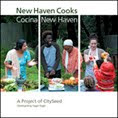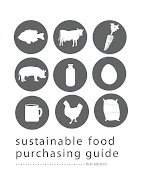When I go to the grocery store or farmers' market I look around at the food and wonder what was done to it before it got to the store cooler or market table. Did it come from a huge farm where the soil was mixed with chemical fertilizers and the plants sprayed with pesticides? Did the farmer spray the fruit directly with pesticides or not? If I eat this food, and serve it to my kids how much of those chemical fertilizers and pesticides will we be ingesting?
While I like to grow some of my food, and I prefer to buy food that is grown with organic or other sustainable farming practices, I can't always find everything organic or ecologically grown, and even if I do, I can't always afford to buy it. I use this Shopper's Guide to Pesticides put together by the Environmental Working Group to help me prioritize which produce I should try and buy organic. The "dirty dozen" side of the list shows produce with the highest levels of pesticide retention after they are grown, and washed. The "clean 15" side shows produce that has the lowest levels of pesticides. Most conventionally grown food (anything not labeled organic) is grown not only with pesticides, but also herbicides and chemical fertilizers. Some produce is grown "sustainably" or using Integrated Pest Management (IPM), which is a process of creating healthy crops through a variety of agricultural techniques to help minimize the use of chemical pesticides and fungicides. You can always try asking the produce worker at your grocery store or the farmer at the market about how the food was grown. A farmer might tell you that they sprayed their peach tree when the flowers were in bloom, but have not sprayed them since the fruit was on the tree, so they are using minimal amounts of chemicals and there should be none on the fruit itself.
Some people say that this list might scare people from eating fruits and vegetables at all. I think that it is important for people to be informed about what they are purchasing and eating, and to make decisions that allow them to balance out the amount of high pesticide residue and low residue foods they eat. For example, I love strawberries, but once the small window for local IPM strawberries is gone, I can only afford to buy organic ones on occasion, so I sometimes buy conventional ones (with chemical residue) but only on occasion, and the rest of the time I use frozen organic ones or choose a different fruit that is lower in chemical residues. If I didn't know that strawberries were high in pesticides, then I would be feeding them to my children regularly, and that is a lot of chemicals for a little body to handle.
Some people say that this list might scare people from eating fruits and vegetables at all. I think that it is important for people to be informed about what they are purchasing and eating, and to make decisions that allow them to balance out the amount of high pesticide residue and low residue foods they eat. For example, I love strawberries, but once the small window for local IPM strawberries is gone, I can only afford to buy organic ones on occasion, so I sometimes buy conventional ones (with chemical residue) but only on occasion, and the rest of the time I use frozen organic ones or choose a different fruit that is lower in chemical residues. If I didn't know that strawberries were high in pesticides, then I would be feeding them to my children regularly, and that is a lot of chemicals for a little body to handle.
For a complete list of all the 49 types of produce tested by EWG, click here.
Here is some info about the Shopper's Guide to Pesticides:
Why Should You Care About Pesticides?
The growing consensus among scientists is that small doses of
pesticides and other chemicals can cause lasting damage to human
health, especially during fetal development and early childhood.
Scientists now know enough about the long-term consequences of
ingesting these powerful chemicals to advise that we minimize our
consumption of pesticides.
What’s the Difference?
EWG research has found that people who eat five fruits and
vegetables a day from the Dirty Dozen list consume an average of
10 pesticides a day. Those who eat from the 15 least contaminated
conventionally-grown fruits and vegetables ingest fewer than 2
pesticides daily. The Guide helps consumers make informed choices
to lower their dietary pesticide load.
Will Washing and Peeling Help?
The data used to create these lists is based on produce tested as
it is typically eaten (meaning washed, rinsed or peeled, depending
on the type of produce). Rinsing reduces but does not eliminate
pesticides. Peeling helps, but valuable nutrients often go down the
drain with the skin. The best approach: eat a varied diet, rinse all
produce and buy organic when possible.
How Was This Guide Developed?
EWG analysts have developed the Guide based on data from nearly
96,000 tests for pesticide residues in produce conducted between
2000 and 2008 and collected by the U.S. Department of Agriculture
and the U.S. Food and Drug Administration. You can find a detailed
description of the criteria EWG used to develop these rankings and
the complete list of fruits and vegetables tested at our dedicated
website, www.foodnews.org.
THE POWER OF INFORMATION
Headquarters 1436 U St. N.W., Suite 100 Washington, DC 20009
(202) 667-6982
Learn More at FoodNews.org











so interesting and helpful. Thanks!
ReplyDeleteI've used the Dirty Dozen list for a few years now and it's great. Glad you posted about it. But do you have any buying tips about baking ingredients? Do you buy aluminum-free baking powder? Organic sugar? Organic vanilla? I'd love your advice on when it's important to shell out for earth- and human-friendly ingredients.
ReplyDelete